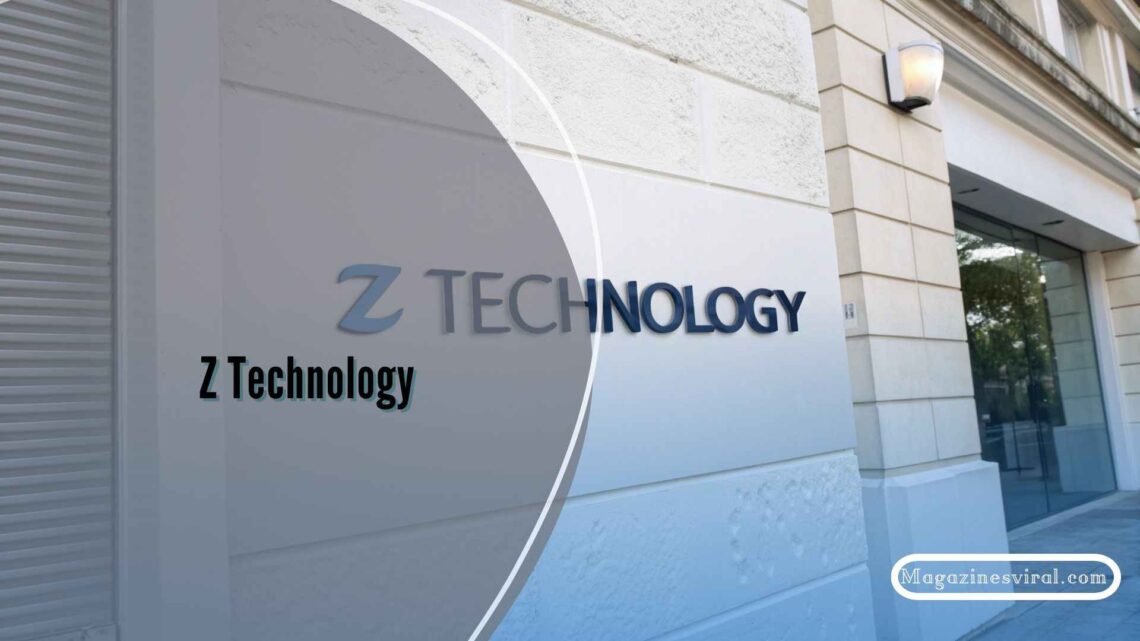Z Technology is a next-gen tech framework combining AI, quantum computing, and IoT to power smarter, faster, and more secure digital systems. It’s transforming industries with real-time data and intelligent automation.
Stay with us to learn more about Z Technology. We’ll keep sharing simple and exciting updates, so you can understand how it’s changing the world around us. Don’t miss out!
What Exactly Is Z Technology?
At its core, Z Technology refers to an advanced system or framework built using a blend of artificial intelligence (AI), machine learning (ML), quantum computing, and next-gen data architecture. While the term “Z” might sound futuristic, it’s quickly becoming a reality in industries like healthcare, finance, cybersecurity, and even space exploration.
Key Pillars of Z Technology:
| Pillar | Description |
| AI & ML | Empower decision-making with real-time data analysis and adaptive learning |
| Quantum Computing | Solve complex problems at speeds traditional computers can’t handle |
| 5G & IoT Integration | Enable seamless communication between devices and systems |
| Advanced Data Encryption | Secure and protect massive volumes of sensitive information |
The Core Components of Z Technology

Let’s take a deeper dive into the essential building blocks of Z Technology:
Quantum Computing
Unlike classical computers, which use bits (0s and 1s), quantum computers use qubits, which can represent multiple states at once. This allows them to solve complex problems exponentially faster, such as:
- Simulating molecular behavior in drug development
- Cracking cryptographic codes
- Optimizing supply chains with thousands of variables
Artificial Intelligence and Machine Learning
AI/ML allow Z-powered systems to:
- Analyze patterns in massive datasets
- Make predictions with high accuracy
- Continuously improve without being explicitly programmed
Edge Computing & IoT Integration
With edge computing, Z Tech pushes computing closer to the data source. When paired with IoT devices, it creates systems that:
- Process data instantly at the edge
- Minimize latency
- Improve efficiency in environments like smart cities or autonomous factories
Advanced Data Security & Blockchain
Z Technology often incorporates blockchain and post-quantum cryptography to protect sensitive data and transactions — making it nearly impossible for cybercriminals to breach modern systems.
Expanded Use Cases of Z Technology
Z Technology is already being tested or deployed in various industries. Here’s a deeper look at some transformative applications:
Healthcare: Predictive Personalized and Preventive
- Digital twins for human patients simulate reactions to treatments before administering them
- Genomics analysis through quantum-powered AI accelerates the discovery of personalized therapies
- AI-driven triage systems reduce ER congestion by instantly evaluating patient severity
Smart Cities and Urban Infrastructure
- Real-time traffic management to reduce congestion
- AI surveillance for improved public safety
- IoT-enabled waste management systems for sustainability
Finance: The Age of Smart Capital
- Quantum algorithms for real-time risk assessment
- AI-powered credit scoring and fraud detection
- Robo-advisors offering 24/7 investment insights customized to user behavior
Manufacturing and Industrial Automation
- AI-guided robots that learn from human technicians
- Predictive maintenance powered by IoT sensors
- Blockchain-based supply chain tracking for full transparency
Agriculture and Environmental Tech
- AI-analyzed drone data for precision farming
- Automated irrigation and fertilization using sensor feedback
- Quantum modeling for climate forecasting and disaster prevention
Z Technology and the Future of Cybersecurity
As cyber threats grow in complexity, Z Technology is the key to building next-generation defenses. Here’s how:
- Self-healing networks use AI to isolate and correct anomalies in real time.
- Post-quantum encryption prepares systems for the age when quantum computing could break traditional security.
- AI threat modeling continuously scans for patterns that indicate potential breaches.
Z Technology vs. Traditional Technologies: A Functional Comparison
| Feature | Traditional Tech | Z Technology |
| Processing Capability | Limited to binary computations | Quantum-enhanced, multidimensional data handling |
| Learning Ability | Rule-based logic | Self-improving AI/ML |
| Scalability | Manual configurations needed | Seamless cloud-edge scalability |
| Speed | Delayed data processing | Real-time, ultra-fast analysis |
| Human Involvement | High | Minimal (human-in-the-loop only when needed) |
Z technology products
Z Technology products can mean different things depending on what you’re talking about:
- IBM Z Technology: Big computers used by banks and governments for handling lots of data safely.
- Z-Wave Technology: Smart home products like smart locks, lights and sensors that connect wirelessly.
- ZTE Products: Phones, routers and tech gear from a company called ZTE.
- Other Z-Tech Companies: Some smaller companies use the name “Z Technology” for software, machines or tools.
Fictional Stuff: Sometimes “Z Technology” is used in games or stories for cool made-up technology.
The Economic and Business Impact of Z Technology
For businesses, Z Tech means unparalleled efficiency, agility and innovation.
Key Benefits:
- Cost Savings: Predictive analytics minimize downtime and optimize resources.
- Faster Go-to-Market: Automated design and simulation shorten development cycles.
- Hyper-Customization: Products and services adapt in real-time to consumer behavior.
- Risk Reduction: Data-driven decisions reduce uncertainty.
Even small businesses can tap into Z-powered cloud solutions to stay competitive in a fast-changing marketplace.
Barriers and Ethical Considerations
Despite its immense promise, Z Technology faces certain roadblocks:
- Infrastructure Gaps: Not all regions have access to 5G, let alone quantum systems.
- Ethical Dilemmas: AI decision-making raises questions about accountability.
- Job Displacement: Automation could disrupt traditional roles without proper reskilling.
- Digital Divide: Ensuring equal access across socioeconomic lines is critical.
Policymakers and technologists must collaborate to ensure that Z Tech benefits everyone.
What Lies Ahead: The Future of Z Technology?
By 2040, experts predict Z Technology will touch every aspect of our lives. Here’s a glimpse of what we might see:
- AI judges aiding in legal decision-making
- Fully autonomous hospitals run by quantum-enhanced AI
- AI artists collaborating with humans to create immersive digital experiences
- Neural interfaces bridging minds and machines in real-time communication
Z Tech won’t replace humans — it will empower us to solve problems once considered unsolvable.
FAQ’s
1. Can Z Technology be integrated with legacy systems?
Yes, although integration can be complex. Many companies are developing hybrid systems that bridge traditional infrastructure with Z Tech solutions. Middleware platforms and APIs play a vital role in allowing existing databases and apps to interface with quantum processors and AI engines.
2. What skills are needed to work in Z Technology-related fields?
Professionals in this field often need a mix of skills, such as:
- Quantum programming (e.g., Qiskit, Cirq)
- Machine learning and AI algorithms
- Cybersecurity and cryptography
- IoT hardware engineering
- Cloud computing and edge infrastructure
The demand for cross-disciplinary expertise is growing fast.
3. How does Z Technology handle ethical decision-making in AI systems?
Z Technology platforms are beginning to incorporate ethical AI frameworks that:
- Ensure bias mitigation
- Provide transparent decision pathways
- Include human oversight (human-in-the-loop systems) Some systems even use AI ethics simulators to test scenarios before implementation.
4. Is Z Technology accessible to small businesses or startups?
While enterprise applications dominate, many cloud-based Z Tech services are now affordable for startups and SMEs. For example, Google Cloud and IBM offer quantum simulators and AI tools with pay-as-you-go models, democratizing access to innovation.
5. What role does Z Technology play in space exploration?
Z Technology is revolutionizing space tech by:
- Optimizing satellite communication via AI and quantum encryption
- Enhancing spacecraft navigation using predictive models
- Supporting planetary data processing in real-time with edge computing
NASA and private firms are already piloting these technologies in missions.
6. Can Z Technology help prevent future pandemics or global crises?
Yes. Its real-time predictive capabilities can:
- Model virus spread scenarios with quantum simulations
- Enable faster vaccine development through AI-driven protein folding
- Power global health monitoring systems with IoT biosensors and AI analytics
Z Technology enhances preparedness and rapid response at an unprecedented scale.
Conclusion:
Z Technology is changing the world faster than ever before. From smarter healthcare to stronger security and faster decisions, it’s shaping a better future. As it grows, those who learn and adapt will lead the way. Now is the time to explore, embrace, and unlock its full power.




